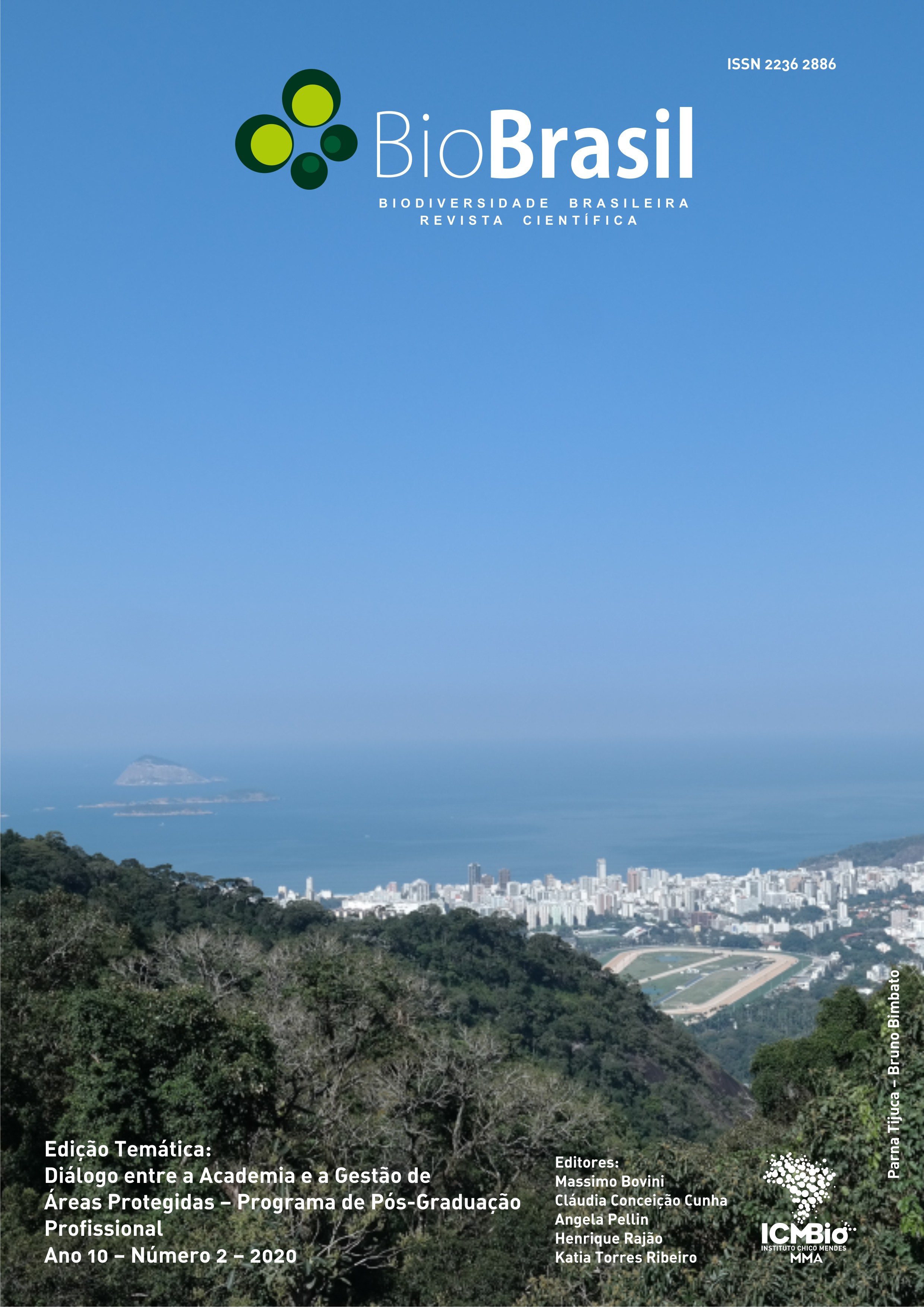Reduction of Forest Fires in the Araras Biological Reserve, Rio de Janeiro, Southeast Brazil
DOI:
https://doi.org/10.37002/biodiversidadebrasileira.v10i2.1464Keywords:
Protected area, buffer zone, Forest Fire Prevention ProgramAbstract
Forest fires represent one of the greatest threats to Protected Area (PA) and to all the biodiversity contained in these areas. Considering that the Atlantic Forest biome is extremely reduced, impacts that result in the loss of habitat and species must be prevented and combated efficiently. The present goal of this study was to outline the profile of the wild forest fire prevention and firefighting actions undertaken in the Araras Biological Reserve (RBA) during the 2014 - 2018 period. The Araras Biological Reserve is a Protected Area (PA) in the State of Rio de Janeiro, located in the municipalities of Petropolis and Miguel Pereira, sheltering a remaining and well-preserved vegetation of native Atlantic Forest. After several visits to the RBA to collect data and for field research, the actions/operations were identified and then classified as Educational and Monitoring. Those actions listed as Educational carry information about the importance and danger risks being taken in the presence of fire by the permanent or transient population of both the Buffer Zone area and the neighboring PAs', to be observed along an entire year period, and are meant to reach the areas' highest possible number of persons and properties. About the Monitoring actions, some demand further attention regarding their execution form, registration and periodicity from both the PA's team and managers. During the period under analysis, a decrease has been verified in the number of wild forest fire incidents, suggesting a possible efficiency of both actions and methods adopted the RBA neighboring population. The results demonstrate that those actions referring to the Forest Fire Prevention and Fire Fighting Program contribute to the integral protection of this Protected Area Unit. 

Â
Downloads
References
Aximoff I, Rodrigues RC. Histórico dos incêndios florestais no Parque Nacional do Itatiaia. Ciência Florestal, 21(1): 83-92, 2011.
Aximoff I. O que perdemos com a passagem do fogo pelos campos de Altitude do Estado do Rio de Janeiro, Biodiversidade Brasileira, 1 (2): 180-200, 2011.
Aximoff I, Bovini MG, Fraga CN. Vegetação em Afloramentos Rochosos Litorâneos Perturbados por Incêndios na Região Metropolitana Fluminense, Estado do Rio de Janeiro, Biodiversidade Brasileira 6 (2): 149- 172, 2016.
Aximoff I, Nunes-Freitas AF & Braga JMA. Regeneração natural pós-fogo nos campos de altitude no Parque Nacional do Itatiaia, sudeste do Brasil. Oecologia Australis, 20(2): 200-218, 2016b.
Bontempo GC, Lima GS, Ribeiro GA, Doula SM & Jacovine LAG. Registro de ocorrência de incêndio (ROI): evolução, desafios e recomendações. Biodiversidade Brasileira 1(2): 247-263, 2011.
Fagundes VJ. 2016. Incêndios florestais em unidades de conservação de proteção integral da região metropolitana de Belo Horizonte, MG. UFLA. 122p.
Google Earth - Mapas. <https://www.google.com/ earth/> Acesso em: 09/2019.
INEA - Instituto Estadual do Ambiente. 2010. Plano de Manejo Reserva Biológica de Araras. www.inea. rj.gov.br/cs/groups/public/documents/document/ zwew/mde5/~edisp/inea001976.pdf. Acesso em: 10/06/2017.
INPE - Instituto Nacional de Pesquisas Espaciais. 2007. Banco de Dados de Queimadas. São José dos Campos - São Paulo. <http://www.inpe.br/queimadas/ bdqueimadas/#>. Acesso em: 09/2018.
Koproski L, Batista AC & Soares RV. Ocorrências de incêndios florestais no Parque Nacional de Ilha Grande - Brasil. Floresta, 34(2): 193-197, 2004.
LimaGS,TorresFTP,CostaAG,FélixGA&Silva-Júnior MR. Avaliação da eficiência de combate aos incêndios florestais em unidades de conservação brasileiras. Floresta, 48(1): 113-122, 2018.
Magnanini A, Lardosa E, Marien JAS, Castro PFVB, Magalhães A, Monise AF, Bomtempo & CBT, Wittur T. 2010. Roteiro metodológico para elaboração de planos de manejo: parques estaduais, reservas biológicas, estações ecológicas. INEA, Instituto Estadual do Ambiente, Rio de Janeiro. 116p.
Martinelli G. Nota sobre Worsleyarayneri (J.D. Hooker) Traub. & Moldenke, espécie ameaçada de extinção. Rodriguésia, 36(58): 65-72, 1984.
Martinelli G, Martins E, Moraes M, Loyola R, Amaro R. (orgs.). 2018. Livro Vermelho da Flora Endêmica do Estado do Rio de Janeiro. Instituto de Pesquisas Jardim Botânico do Rio de Janeiro: Andrea Jakobsson, Rio de Janeiro. 456p.
Motta DS. 2008. Identificação dos fatores que influenciam no comportamento do fogo em incêndios florestais. UFRRJ, 24p.
Pereira AA, Pereira AJA, Morelli F, Barros DA, Weimar AJr., Soares F, Scolforo JR. Validação de focos de calor utilizados no monitoramento orbital de queimadas por meio de imagens TM. Cerne 18(2): 335-343, 2012.
QGIS userguide: versão 2.2. Disponível em . Acesso em: 20/12/2018.
RezendeCL,ScaranoFR,AssadED,JolyCA,MetzgerJP, Strassburg BBN, Tabareli M, Fonseca & GA, Mittermeier RA. From hotspot to hotspot: An opportunity for the Brazilian Atlantic Forest. Perspect Ecol. Conserv., 16(4): 208-214, 2018.
Rodrigues JA, Libonati R, Peres LF & Setzer A. 2018. Mapeamento de Áreas Queimadas em Unidades de Conservação da Região Serrana do Rio de Janeiro Utilizando o Satélite Landsat-8 durante a Seca de 2014, p. 318-327. In: Anuário do Instituto de Geociências 41, UFRJ.
Santos LMB, Alvarenga LJ & Miranda MPS. 2017. A sinalização como instrumento de informação e proteção ambiental. 22o Congresso Brasileiro de Direito Ambiental. Teses de Profissionais/Independent Papers, v. 1. 802p.
Tebaldi ALC. Ações de prevenção e combate aos incêndios florestais nas unidades de conservação estaduais do Espírito Santo. Floresta e Ambiente, 20(4): 538-549, 2013.
Torres FTP & Lima GS. Forest Fire Hazard in the Serra do Brigadeiro State Park (MG). Floresta Ambiente 26 (2): e20170304, 2019.
Downloads
Published
Issue
Section
License
Copyright (c) 2021 Biodiversidade Brasileira - BioBrasil

This work is licensed under a Creative Commons Attribution-NonCommercial-NoDerivatives 4.0 International License.
Os artigos estão licenciados sob uma licença Creative Commons Atribuição-NãoComercial-SemDerivações 4.0 Internacional (CC BY-NC-ND 4.0). O acesso é livre e gratuito para download e leitura, ou seja, é permitido copiar e redistribuir o material em qualquer mídia ou formato.












